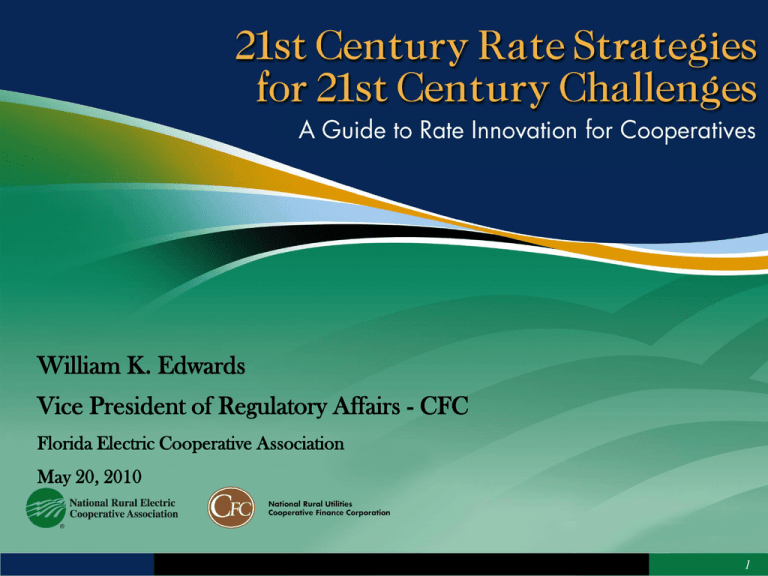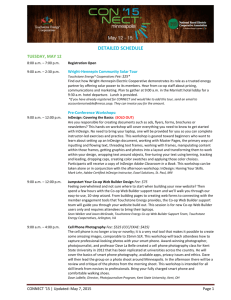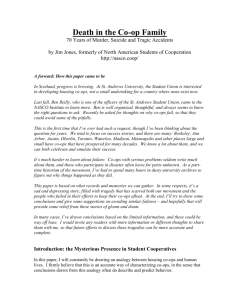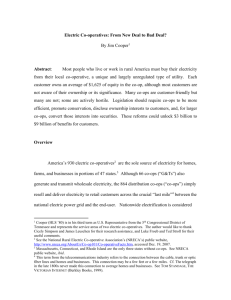
William K. Edwards
Vice President of Regulatory Affairs - CFC
Florida Electric Cooperative Association
May 20, 2010
1
Background
Joint NRECA & CFC study
Updates 1989 report “Rate Issues and Strategies”
20 years since last joint study – a period of stable
rates
2
Sources
Focus group and panels (CFC Forum)
Input from rate consultants and panels (NRECA Rate
Summit)
Input from NRECA Innovative Energy Strategies Task
Force
Presentation and Panels at Regional Meetings
Panels at CFC Independent Borrowers Meeting
NRECA and CFC newsletter articles
3
About the report
Intended as a helpful resource
A starting point for discussions about rates
Not an exhaustive review of rate issues
Not a “to do” list
All suggestions don’t fit all co-ops
4
Why This Report?
New Challenges for Co-ops
Higher demand growth than IOUs
Rising construction costs
Growing interest in energy efficiency
State and Federal Mandates
Climate Change Mitigation Proposals
These trends may make it harder for co-ops with
traditional rates to recover costs & margins.
5
Index
1974 = 100
Co-ops Continue to Lead
Industry kWh Growth
450
Co-ops
4.2%
400
350
300
250
Total Industry
2.4%
200
150
19
74
19
76
19
78
19
80
19
82
19
84
19
86
19
88
19
90
19
92
19
94
19
96
19
98
20
00
20
02
20
04
20
06
100
Source: DOE/EIA
6
Projected Electricity Use
Index
2008 =100
Average Growth Rates: Co-ops v. Total Industry
2008-2035
Co-ops
1.75%
Total Industry
60%
1.0%
30%
Source: Based on EIA AEO 2010
7
Co-ops Entering A New Building Cycle
$ Billions
A power plant that costs $1billion in 2000 would have
Cost $2.17 billion in 2009 – IHS CERA
projected
(survey results)
Loans Approved*
*not all loan approvals (shown in green) were subsequently drawn-down
Source: 2009 G&T Survey
8
Growing Co-op and Consumer Interest
in Energy Efficiency
Co-ops
–Avoid building high cost
generation
Consumers
–Reduce bills
–Take advantage of incentives
9
State and Federal Mandates
30 states & D.C. have RPS programs
requiring electricity providers to acquire a
percentage of generation from renewable
resources.
39 states & D.C. have adopted net
metering requirements.
19 states & D.C. have adopted Energy
Efficiency Portfolio Standards.
10
Carbon Auction Impacts on Co-op Residential Bills
This map shows how a $20 cost per metric ton of carbon dioxide (CO2) could
increase the monthly bill of an average electric co-op residential consumer.
WA
0%
ND
26%
MT
6%
OR
0%
ID
0%
CA
4%
UT
28%
AZ
16%
MN
24%
WI
17%
SD
22%
WY
23%
NV
9%
ME
6%
NE
18%
PA
6%
KS
15%
OK
19%
NM
14%
MO
23%
AK
6%
WV
17%
KY
26%
NJ
6%
DE 11%
MD 13%
VA
9%
NC
8%
TN
17%
AR
21%
SC
18%
MS
16%
TX
14%
OH
21%
IN
21%
4%
NY
2%
MI
15%
IA
15%
IL
20%
CO
19%
VT
4% NH
AL
16%
GA
12%
LA
23%
Percent Increase:
FL
16%
High 15% and above
1 Metric Ton = 2,204.6 pounds
Source: 2007 EIA data
Strategic Analysis Unit
May 2009
HI
2%
Medium 9% to 14%
Low 0% to 8%
© NRECA, all rights reserved. May not be copied, reprinted, published, translated, hosted or otherwise distributed by any means without explicit permission.
11
Carbon Auction Impacts on Co-op Residential Bills
This map shows how a $50 cost per metric ton of carbon dioxide (CO2) could increase
the monthly bill of an average electric co-op residential consumer.
WA
1%
OR
1%
ME
15%
ND
65%
MT
14%
ID
1%
MN
59%
WY
58%
NV
23%
UT
70%
CA
9%
AZ
40%
WI
43%
SD
55%
CO
47%
PA
16%
IL
50%
KS
38%
OK
46%
NM
36%
TX
35%
NJ
15%
OH
52%
IN
51%
MO
58%
KY
65%
WV
43%
DE 27%
MD 31%
VA
23%
NC
19%
TN
42%
AR
53%
SC
46%
MS
40%
AK
16%
MI
38%
IA
37%
NE
46%
VT
10% NH
9%
NY
6%
AL
41%
GA
30%
LA
57%
Percent Increase:
FL
40%
High 15% and above
1 Metric Ton = 2,204.6 pounds
Source: 2007 EIA data
Strategic Analysis Unit
May 2009
HI
4%
Medium 9% to 14%
Low 0% to 8%
© NRECA, all rights reserved. May not be copied, reprinted, published, translated, hosted or otherwise distributed by any means without explicit permission.
12
cents per kWh
Source: EIA and CFC
December 2009
Rates Have Increased 39% Since 2000
Implications of Industry Trends
Higher costs
Potential for
lower per-capita usage
Compatible with current
rate structure?
14
Rate Suggestion 1
Integrate Rates with the
Business Plan
Cooperatives should consider including
rate objectives as key components of
an integrated business plan that
addresses the new challenges facing
the electric industry.
15
Why Integrate Rates?
Rates need to be compatible with technology, power
supply, communications non-rate programs, member
services and financial goals
Synergies are created when all co-op functions work
together
Industry challenges require more extensive advance
planning
Example: If a co-op is planning to implement time of use
rates its technology plan needs to budget for TOU
meters
16
Rate Suggestion 2
Adopt a Rate Policy Statement
Cooperative boards, working with
management, should consider adopting a rate
policy statement that provides specific
objectives for rates that support the
cooperative’s strategic goals.
17
Rates and rate policy provide important
support of a cooperative’s strategic goals.
18
Elements of a Rate Policy Statement
Establish targets to meet the cooperative’s strategic
financial goals
Set objectives for rate design
Examine the fairness of rates
– between classes of customers
– within customer classes
Identify issues other than cost of service that should be
considered.
Provide other necessary direction to staff
19
Examples of Rate Policy Objectives
The Co-op will implement rates based on an
embedded cost of service study.
Costs should be allocated to the rate classes
causing costs to be incurred.
All members must provide a margin to the system.
Rates should support energy efficiency.
Collect fixed costs via fixed charges, variable
costs via variable charges.
20
Rate Suggestion 3
Support Financial and Other Strategic Objectives
through Effective and Complementary Rate Design
Retail rates should be designed to:
– Consistently produce sufficient revenue to recover the cost
of providing service to consumers, including its margin
targets.
– Give price signals to consumers that are aligned with the
strategic objectives of the business plan.
– Minimize abrupt changes in rates through use of automatic
adjustments clauses.
– Assure compliance with legal and tax requirements
21
Rate Design Communicates Price Signals
Sample size = 372 Distribution Co-ops
61% of co-ops now have a wholesale
power adjustment clause
Sample size = 372 Distribution Co-ops
Antidiscrimination Considerations
“Discrimination in rates is not permitted as
between customers similarly situated;
however, because a difference in charges
may be justified under some circumstances,
not every difference is an unlawful
discrimination.”
-- 29 C.J.S. Electricity § 67 (2009)
24
Federal Tax Law Considerations
•
To maintain exempt status, a cooperative must
operate on a cooperative basis, which requires,
among other things, equitably allocating costs
and revenues.
•
Excessive cross-subsidization between member
rate classes may violate cooperative tax law
principles.
•
The more a cooperative deviates from strict
cost-based accounting by rate class, the
greater risk it runs of not operating at cost.
25
Rate Suggestion 4
Consider Decoupling Revenues from Sales
Cooperatives should consider moving, to the extent
practicable, toward recovering costs in the way they are
incurred. Fixed costs and margins should be recovered
through fixed charges, and variable costs should be
recovered through variable charges.
To the extent that this cannot be fully achieved, due to
competitive pressures, cooperatives should consider
adopting an adjustment mechanism clause that permits
recovery of appropriate margins, regardless of kWh sales.
26
Aligning Costs & Charges
Costs
Components
Charges
Customer
• Consumer Acct/Sales
• Portions of A&G,
Dist O&M, Depreciation
Fixed Monthly
Charge per
Customer
Demand
• Wholesale Power Bill
Demand Components
• Transmission O&M
Metered
Demand
• Portions of A&G,
Dist O&M, Depreciation
Energy
• Wholesale Power Bill
Energy Charges
Variable per
kWh Charge
27
U.S. Median Distribution Co-op
% of Revenue
Wholesale
Power Bill
65%
Energy
Demand
Other
Costs
35%
Customer
28
Cooperative and Investor-Owned
Utility (IOU) Customer Charges
Graph based on sample of 371
distribution co-ops and 163 IOUs
Revenue Trackers
ABC Electric Cooperative
Ceiling 2.5
Floor 1.75
Rate Suggestion 5
Align Wholesale and Retail Rates
with Wholesale Cost Drivers
–G&Ts should consider designing rates that reflect
wholesale cost drivers.
–G&T and distribution systems should consider
coordinating rate policies in order to align both
wholesale and retail rates to send the appropriate price
signals to consumers.
31
Wholesale – Retail Coordination
Win / Win
Power Supply costs 65% of electric bill.
Wholesale power costs depend on load
characteristics of distribution co-ops.
Wholesale rates should reflect wholesale cost
drivers
Distribution systems’ rates should send the
correct price signals to consumers.
32
Benefits of Coordinating Rates
Delay the need for new generating capacity
Delay the need for new T & D capacity
Reduce exposure to high fuel prices and high wholesale
market price for electricity
Reduce coincident peak demand
Develop energy efficiency and demand response capacity
resources
Better utilize technological capabilities
Help consumers to manage their bills
33
Rate Suggestion 6
Develop a Rate Implementation Plan
–Rate implementation plans assist a cooperative to
achieve member, community, and regulatory acceptance
of rate changes and continued satisfaction with the
cooperative.
–A key aspect of such a plan is internal coordination of
rate objectives and activities across a co-op’s functional
lines.
34
Implementation Plan Promotes
Member Satisfaction
Assure
adequate technological capabilities to
support tariffs.
Introduce rate
adjustments at a time that will have
the least impact on consumers.
Explain co-op’s rate
strategy to key audiences.
Empower consumers to
manage energy use and
bills.
35
A Plan Should Address
Schedule for
ratemaking process
Assigned roles and responsibilities for
successfully implementing the rate change
Approach to
educating key audiences
Technology, software staff,
staff training and
other resources needed to implement the change
smoothly
36
A Plan Should Address
Timing of
Ways to
Cont.
rate adjustments
help members manage their energy
usage
Timely review of rate
schedules to ensure
intended result
Adequate budget support
37
Coordination Enhances
Financial performance
Member
relations
Communications
Business development
System
engineering and operations
Long-term technology acquisition
Other
cooperative functions
38
Rate Suggestion 7
Review Rates At Least Annually
An annual review of rate strategies and
policy is recommended – more
frequently if a significant change
occurs.
39
Reasons for Annual Review
Avoid
delaying rate increases
Determine
if rates are contributing to
co-op goals
Evaluate
Modify
consumer response to rates
rate design if needed
40
41












